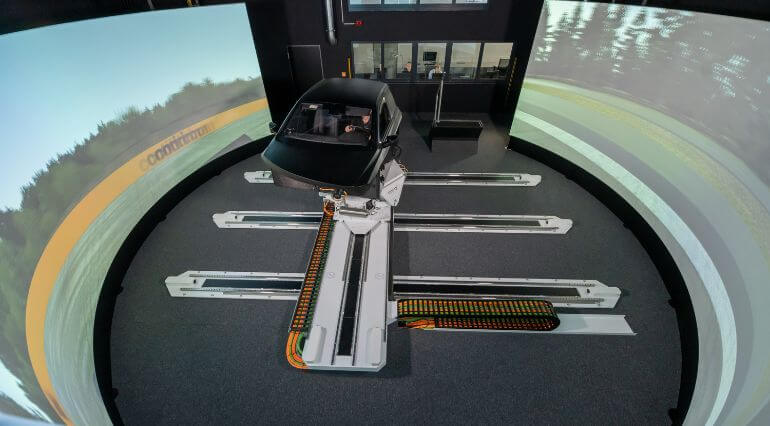Join the conversation
We love to hear from our customers. Connect with us today and let’s start a conversation.
...searching
Blackcircles.com visits Continental's cutting-edge Jeverson test facility for an insightful comparison between like-for-like new and old tyre designs.
Whether it’s mobile phones, golf clubs, or tyres, the vast majority of consumer products follow a seemingly perpetual cycle of updates and improvements, culminating in the latest all singing and dancing models being released on a regular basis. Ultimately, this leads the cynical voice within us to question: how much improvement has actually been made over the previous model? Is the new version simply a marketing exercise devised to sell more product? And, what am I getting for my money?
Well, thanks to an exclusive behind-the-scenes insight from Continental, we can now share a helpful comparison between newly manufactured (eliminating the impact of rubber degradation through time) old model tyres and Continental’s latest SportContact 7 tyre. In the process, hopefully dispelling some myths around tyre development and progress over the last two decades.
The Contidrom: A tyre tester’s utopia
We begin around 40km north of Hannover, Germany, at Continental’s world-renowned proving ground: the Contidrom. Opened in 1967, the ‘drom was one of the first of its kind in Germany and has put an astonishing 1.5 million tyres through their paces since its inception. Here, Continental has the facility to test almost any dynamic property and characteristic of a tyre, from aquaplane resistance, ride comfort, handling balance and much more besides.
Enter your registration and postcode and we’ll show you the best tyres for your car
Aside from testing its own tyres at the Contidrom, Continental also benchmarks competitors' offerings, as well as working directly with car manufacturers to ensure models, such as the BMW 5 series, are developed to retain signature handling traits and qualities. Thus, Continental’s test track provides the perfect platform for our new vs old comparison.
Helping to further bolster the accuracy of the test, is the fact that we can effectively wind back the clock by using tyres which have been freshly manufactured using the same design, technology and materials that Continental employed 20 years ago. While this might sound excessive, as rubber is a naturally occurring product it would be almost impossible to determine how the ageing process has affected the performance of a tyre which was manufactured in period.
Track test time
Representing Continental’s old design is the ContiSportContact 2 tyre. Launched to great acclaim in 2003, ContiSportContact 2 was the pinnacle of Continental’s high performance summer range at the time and is an ancestor of the latest SportContact 7.
Continental’s wet small handling course provided the best environment for the comparison, with its slipperier surface maximising the amount of feedback due to a lower grip threshold.

To set a benchmark, we first jump into our SportContact 7 shod VW Golf GTI and begin putting the car through its paces around a sequence of increasingly tight and technical turns.
Immediately apparent is the sheer amount of grip, control and predictability provided by the modern tyre, despite the treacherous conditions forcing it to really work for a living. While feedback and feel are equally impressive and make it easy to tell when you are approaching (and pushing past) the limit of adhesion. Just one lap around such a demanding track is all it takes to understand why the new SportContact 7 has been bestowed with multiple awards from independent tyre testers.
Back on track in the same GTI and riding on Continental’s old ContiSportContact 2, the difference between old and new is immediately apparent without even reaching for a stopwatch — we get to that a bit later.

Most striking is the difference in absolute grip between the pair, as the old tyre gives up the ghost and pushes wide at significantly lower entry speeds. The overarching feeling was that the old tyre felt narrower than its modern counterpart — although both were actually identical widths. Despite retaining a safe feel and a respectable level of traction, the improvements across the board between the ContiSportContact 2 and 7 were striking to say the least.
But that’s not a scientific test, that variance could be caused by your own inconsistent driving style, we hear you cry. Fear not though, for the objective part of the test we left the driving to the professionals.
Queue Continental’s in-house test drivers. With a career as a professional racing driver already under their belt, Continental’s drivers then receive an additional three years of training to ensure their expert deductions about a tyre are consistent with their co-workers and the brand’s standard. Most importantly, this allows them to achieve almost robotic levels of repeatability and accuracy: perfect when pitting two tyres against each other.
With the stopwatch now running, Continental’s expert driver extracts every ounce of grip the new tyres have to offer, completing the sodden 1800m handling track in a brief 80 seconds flat on the new tyre. After completing a second timed lap with the older tyre (with equal levels of vigour and determination) we get an objective conclusion. Cementing our initial thoughts, the old tyre takes a full 6 seconds more to complete the same course. It would appear then, that when it comes to tyres, you can’t halt progress.
Testing and development
How has Continental made such great strides in performance over the last two decades then? Well, according to Philipp Must, Head of Technical Customer Interface Management ww, it’s less a question of what’s changed, but rather a matter of what hasn’t?
Must argues: "Although remaining black and round, the evolution in tyre technology has been dramatic within the last 20 years, leading to further safety improvements that one can feel."
Starting with a clean slate for each new model, Continental redesigns every aspect of the tyre from compound and construction to contour and pattern. This ensures that they: "Turn each and every stone to find opportunities for a performance advantage."

With some of the biggest game changers in recent years including advancements in the fields of virtual development (think driving-simulators, but also AI), chemistry (more sophisticated but also sustainable compound materials), and processing (the grade of automation and precision in tyre production).
While new doesn’t always equal better in the automotive world – you could write a lengthy book on failed successors such as VW's Golf GTI 4 and Ford's Mustang 2 – when it comes to Continental tyres the evidence is indisputable. Armed with this knowledge, would you consider upgrading to the latest tyre model?
We love to hear from our customers. Connect with us today and let’s start a conversation.